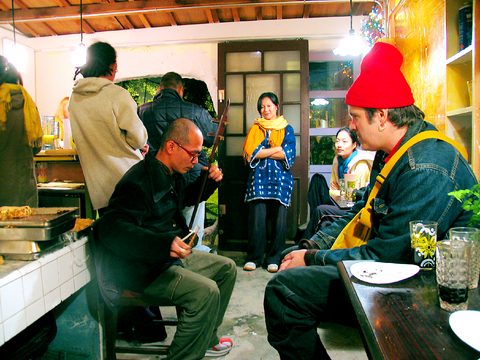The opening of a general store may not ordinarily warrant a mention in the newspaper, but the Treasure Hive, which opened its doors to the public at Treasure Hill last Sunday is part juice bar, part performance space, part soup kitchen, part grocery store, part local pub.
But it's mostly the latest chapter in the half-century saga that has seen Treasure Hill go from an anti-aircraft installation to an art installation.
"It's great to see somebody doing something here that is going to stay and to see this area revitalizing," said Yeh Wei-li (

PHOTO: DAVID MOMPHARD, TAIPEI TIMES
Treasure Hill got its start when the soldiers of the Chinese Nationalist Party (KMT) came to Taiwan.
The area was fortified and designed to protect the city's southwestern side from a Communist air attack. The soldiers stationed there built homes next to the guns they manned and married local girls.
By the time the guns were eventually removed, the area had become home and the soldiers stayed. Now there are ongoing plans to turn several of Treasure Hill's dilapidated structures into facilities that will host an artist-in-residence program.
Treasure Hive, located at the front of the community by a bicycle path that runs along much of the Danshui River, could be considered the first of the structures in the new artist community. Its proprietor, Mina Chin (覃敏怡), says she'll host weekly music performances on the lawn adjacent the store, will serve up a soup of the day, and plans to offer a variety of staple goods which she'll deliver to elderly locals.
The Treasure Hive is at 3, Alley 16, Ln 230, Dingzhou Rd, Sec. 3, Taipei (

This month the government ordered a one-year block of Xiaohongshu (小紅書) or Rednote, a Chinese social media platform with more than 3 million users in Taiwan. The government pointed to widespread fraud activity on the platform, along with cybersecurity failures. Officials said that they had reached out to the company and asked it to change. However, they received no response. The pro-China parties, the Chinese Nationalist Party (KMT) and Taiwan People’s Party (TPP), immediately swung into action, denouncing the ban as an attack on free speech. This “free speech” claim was then echoed by the People’s Republic of China (PRC),

Exceptions to the rule are sometimes revealing. For a brief few years, there was an emerging ideological split between the Democratic Progressive Party (DPP) and Chinese Nationalist Party (KMT) that appeared to be pushing the DPP in a direction that would be considered more liberal, and the KMT more conservative. In the previous column, “The KMT-DPP’s bureaucrat-led developmental state” (Dec. 11, page 12), we examined how Taiwan’s democratic system developed, and how both the two main parties largely accepted a similar consensus on how Taiwan should be run domestically and did not split along the left-right lines more familiar in

Many people in Taiwan first learned about universal basic income (UBI) — the idea that the government should provide regular, no-strings-attached payments to each citizen — in 2019. While seeking the Democratic nomination for the 2020 US presidential election, Andrew Yang, a politician of Taiwanese descent, said that, if elected, he’d institute a UBI of US$1,000 per month to “get the economic boot off of people’s throats, allowing them to lift their heads up, breathe, and get excited for the future.” His campaign petered out, but the concept of UBI hasn’t gone away. Throughout the industrialized world, there are fears that

Most heroes are remembered for the battles they fought. Taiwan’s Black Bat Squadron is remembered for flying into Chinese airspace 838 times between 1953 and 1967, and for the 148 men whose sacrifice bought the intelligence that kept Taiwan secure. Two-thirds of the squadron died carrying out missions most people wouldn’t learn about for another 40 years. The squadron lost 15 aircraft and 148 crew members over those 14 years, making it the deadliest unit in Taiwan’s military history by casualty rate. They flew at night, often at low altitudes, straight into some of the most heavily defended airspace in Asia.